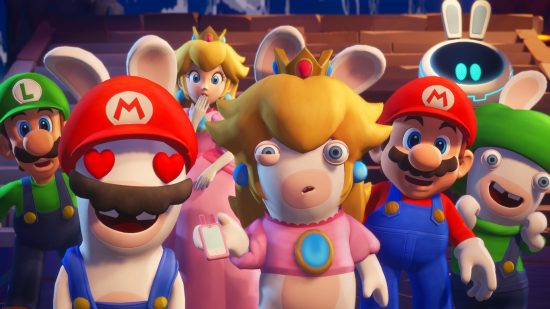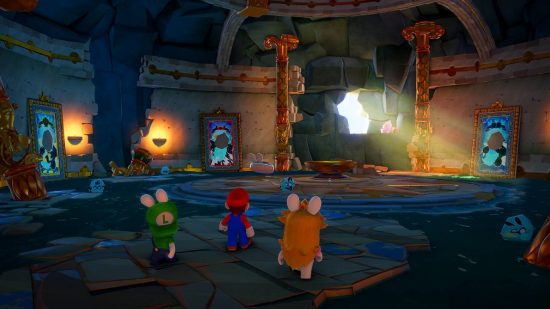Our Verdict
Mario + Rabbids: Sparks of Hope takes the best bits of Kingdom Battle, distilling it into a winning strategy game recipe that'll be played for years to come.
When a leak first revealed that Mario was going to be teaming up with the Rabbids from Rayman for a strategy game, not everyone was thrilled. Fans had their reservations – myself included – but Kingdom Battle ended up proving that Mario can really be dropped into any genre with great results. Fast forward five years, and Ubisoft is looking to repeat that success this time with Davide Soliani’s Mario + Rabbids: Sparks of Hope.
By now, most Mario fans are well acquainted with Soliani, the director of Kingdom Battle, the Donkey Kong DLC, and now Sparks of Hope. In fact, many of us remember him getting teary eyed, watching Mario maker Shigeru Miyamoto get up on stage and commend his work on the game. Well, those tears were worth it, because like everything Soliani has touched before, the game is pure gold.
But what exactly is different about Sparks of Hope from its predecessor? Well, the action now takes place across an intergalactic space voyage, Rabbid Lumas (known as Sparks) can be equipped to offer battle boosts, and the strategy gameplay is no longer confined to a strict grid. That last one is especially important, as gameplay now feels less like XCOM and more like Valkyrie Chronicles.

And while those are welcome changes, Sparks of Hope doesn’t do a very good job of explaining its setting. While newcomers don’t exactly need to know the background behind the game, there is a strange disconnect from the world of Kingdom Battle, leaving no explanation as to why the Rabbids start taking on the appearance of characters of the Mushroom Kingdom. Still, you can enjoy the game without all of that, but it does take away from Sparks of Hope’s overall immersion.
This time around, though, the galaxy is under threat from a looming force known as Cursa, which leads to the Mushroom Kingdom gang and the Rabbids having to take off into space to try and stop them. Along the way, they visit several different alien worlds, face off in tactical strategy battles, and purify cursed areas overrun with black tendrils and gross appendages. In short, the effects of Cursa’s curse are spreading through the galaxy, and it’s up to you and your gang to stop them.
That’s about all you need to know for the story, but it’s all told with the same trademark slapstick style and wit that sold so many fans on the original. With the exaggerated characters and the family-focused fun, Sparks of Hope often feels like an Aardman film, and I mean that in the best possible way. There are genuine laughs in almost every line of dialogue, thanks to the fact that most of the characters you meet along the way are larger-than-life caricatures, who all have something to say.
The most important thing about Sparks of Hope, though, is the battles. While Kingdom Battle laid the foundations for the system, Sparks of Hope has built on them, bringing true innovation to the fore. This is, in part, thanks to the change from a grid-based system to an open exploration system. Now players are dropped into levels and can only move each party member so far, but, as mentioned, gone is the grid and you can instead move them wherever you want (within their distance limitations), and tuck them behind cover to avoid enemy fire.
I wasn’t initially excited about this small change, but after getting to grips with the battle system, I quickly realised that it opens them up so much more, providing fluidity that now gives agency to movement over attacks. Characters can freely move around during their turn before they attack, and can also assist each other with a helpful team jump, allowing either character to leap high into the air and slowly helicopter back down. This is great for reaching higher parts of levels to rain attacks down and position yourself in a tactically advantageous position.
The levels here feel larger and more focused on verticality, offering many easy ways to explore and ledges or railings to duck behind. It’s integral that you place all your units somewhere they can withstand enemy fire, but each element of the level is also destructible so a few well-aimed shots will eventually crumble a wall and make contact with Mario himself. The point is to keep moving and to keep pressing forward.
Having played Kingdom Battle extensively, Sparks of Hope feels so much more active. The changes to movement are in tandem with a more aggressive rogues gallery, a slew of new abilities, and the aforementioned changes to the size and diversity of the levels. I’m not sure if I was rusty, but I found myself easily surrounded in some early levels, as playing conservatively and trying to hold all my characters down in one area, was normally rewarded with a few enemies either side and nowhere to go.
Sparks of Hope wants you to fan out, to take advantage of every nook and cranny, and it also wants you to explore with the many different weapons and sparks. The different enemies will use an array of elemental attacks or different battle techniques, and your main weapon against them is those Sparks. It’s really, really, weird seeing Rabbid versions of Super Mario Galaxy’s Lumas, but they are actually quite adorable, and they each offer battle powers that can be equipped by different party members.
Each of your party of three or four (depending on the battle) can quickly equip two sparks each, and you are very often rewarded with a Spark just for completing a level. There’s a whole host of them to find, offering techniques like attack buffs, adding burn effects to attacks, deflecting some incoming damage back to the attacker, and so many more smart twists. Each character also has an individual power, and along with the Sparks, these can be used every turn in battle with a cool-down of two or three turns.
Honestly, I think some may mistakenly look at the Mario + Rabbids games as tactics for children – and don’t get me wrong it absolutely can be with a couple of settings tweaks – but it’s much more than that for anyone who loves the genre. Sparks of Hope is a high-quality game that offers so much depth and I have had a blast swapping out different party members to test their attacks and their skills, and then equipping different Sparks to try to balance the best abilities with their weapons. Luigi uses a sniper-like bow and arrow, so I like to add the burn ability to his attacks, hit enemies from a distance, and then watch the burned enemy set other foes on fire as they flail around.
There is no doubt the battles are the shining glory of Sparks of Hope, but you will be spending a lot of time exploring the planets you visit as well. While these are also well designed, each with its own fun theme and secrets to discover, the actual exploration is very basic and can feel a bit cumbersome. Remember, none of these characters can jump, and while you’re no longer being led around by Beep-O like in the original, actual movement can still feel a bit restricted and sluggish.
Levels have blockades scattered around, and mostly these consist of fetch missions like grabbing a specific artefact and taking it to the matching lock. It’s clearly designed to work for kids, and it’s passable, but I found myself becoming quite bored on planets, desperate to find yet another battle to enjoy. Luckily, there are other things to do, like timed coin challenges, to mix things up, and, over time, unlocked abilities will help you discover more hidden secrets on planets you’ve already explored. There is a lot to find, and anyone looking to 100% complete Sparks of Hope will have some work on their hands. It’s not all thrilling, but there certainly is a lot to do.
What brings these two things together, though, giving Sparks of Hope that famous Soliani Midas Touch, is the presentation of it all. It’s an understatement when I say that Sparks of Hope is gorgeous. Each planet is beautifully designed, and while they might be full of bloat, I often found myself stopping to admire the falling snow and the dazzling crystalline ice walls. The only thing with this is that Ubisoft has paid the ultimate price in terms of performance.
Unfortunately, I noticed huge framerate drops in-game. Although the battles seemed locked at 30 FPS, exploring the planets in my free time seemed to have quite an effect on my frame rate – especially if I needed to move the camera. It’s such a shame since it’s clear the team is attempting something quite ambitious – even if it is for the Nintendo Switch.
Look, Mario + Rabbids: Sparks of Hope doesn’t reinvent the wheel, but it fulfils the promise of the original. Every element feels refined and expanded. The changes to combat make the battles feel more open and more fluid and challenge you to get to grips with the levels and your abilities to ever hope to turn the tide. The production values of the game also mean it feels more like an animated movie, which is perfect for the audience it’s clearly trying to attract.
If you didn’t like the Rabbids the first time then this review might not convince you to play, but any adult strategy or Rabbids fan really owes it to themselves to give it a shot. It’s a gorgeous adventure only occasionally let down by its exploration elements, and while the story doesn’t do anything wild, the Ubisoft team act as careful caretakers of Mario and pals, with the space-faring backdrop allowing for some really fun moments in a 30-40 hour romp through the galaxy.
But what else did we expect from Soliani? The director has put his heart and soul into this game and it shows.



